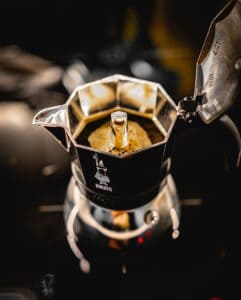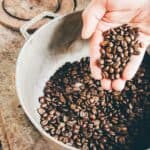Coffee Blooming: Are You Missing Out?

Let’s cut to the chase. Blooming coffee involves pouring freshly boiled water over coffee grounds to release their excess CO2. The initial wetting process involves de-gassing the coffee, which reduces its bitterness and sourness.
You might be thinking, is all this really necessary? Is this just another piece of the coffee making ritual that doesn’t actually improve the end result? Well I had the same questions and wanted to find out.
What is Coffee Blooming?
Coffee blooming may be a new term to you, so let’s walk through what it actually means, how it works and why it’s done by coffee aficionados the world over.
The objective of blooming your coffee is to improve its taste.
The blooming phase of coffee preparation aims to remove excess CO2 that is built up in the coffee beans that may add bitterness and sourness to your brew. The idea is that by pouring a small amount of hot water over your coffee grounds and letting them swell up, you’ll allow some of those gases to be released before continuing on with the pour.
Whilst blooming can technically be done with all coffee brewing methods, some lend themselves to blooming better than others.
We’ll explore the differences between these later on in this article, but you may be most familiar with blooming in a V60 or Aeropress, as these provide two very visual examples.
Why Blooming Coffee is Important
Blooming may seem like a bit of faff that gets in the way of you enjoying a delicious cup of coffee, but I’d actually beg to differ.
Coffee Brewster does a great job of explaining the coffee blooming process in his video below, describing how the additional carbon dioxide escapes the coffee beans, and how it got there in the first place.
The grinding process causes carbon dioxide to be released from the coffee beans very quickly, and this is sped up further with the addition of hot water.
The release of CO2 from the coffee helps release some of the bitterness and sourness that would otherwise end up on your cup, whilst also ensuring a more even extraction and a more balanced tasting brew.
Makes the Coffee More Porous
The idea here is that by releasing that additional CO2 that is trapped in the coffee grounds, you open up the grounds and make them more porous. This makes it easier to extract coffee oils from them, as water can flow more easily through the wetted bed of coffee.
Reduces Bitterness/Sourness
The release of CO2 from the coffee bed removes some of that unwanted bitterness and sourness that would otherwise end up in your cup.
This is also true in espresso. If you remove the crema (which is just leftover built up CO2 being removed from the coffee under intense extraction), your espresso will tend to taste less bitter and acidic.
Even Extraction
If you go for a single pour without blooming your coffee bed first, you run the risk of an uneven extraction due to a certain percentage of the water being suspended in the coffee grounds whilst the CO2 is released.
This means that your coffee bed will extract at a different rate at the top compared to the bottom, and you may well end up with a sour or bitter brew.
Prevents Channelling
Wetting coffee grounds and distributing them more evenly before continuing to pour can really help reduce the risk of channelling.
Localised channelling is the arch enemy of great coffee brewing, as it over extracts some areas of the coffee bed, whilst under extracting others.
This leads to sourness, bitterness and astringency in your brew, which ultimately leaves a nasty taste in your mouth.
Stages of Blooming
Here are the different stages of coffee blooming, broken down into their individual parts.
Wetting
The first stage of coffee blooming is called ‘wetting’.
This is simply pouring a small amount of hot water over your bed of coffee grounds to allow the blooming process to begin.
The easiest way to know how much water to use is with a set of scales, but if you don’t have any available then try to add enough water for the coffee to double in size at least.
I would recommend starting your pour in the centre of the coffee grounds bed, and then moving in a circular motion to ensure all of the coffee grounds are covered with water evenly.
Degassing/Bubbling/Turbulence
Once the coffee grounds have been wetted, they will start to swell or bubble up. This expansion in the coffee ground’s size and volume is known as ‘turbulence’, and is the process of CO2 rapidly being expelled from the coffee.
This may be cool to look at, but it is actually a very crucial stage of the blooming process.
Whilst the coffee grounds are swelling up during turbulence, they are unable to absorb any more water and release their flavour compounds into the brewed liquid below.
Therefore, if you go for a straight pour without allowing the coffee to bloom and release this CO2 first, a certain amount of water won’t actually be extracting soluble coffee oils, as it will be used up releasing CO2.
Therefore, you’ll end up with an uneven extraction and an unbalanced, potentially bitter and astringent cup of coffee at the end.
Stirring/Swirling (Agitation)
As the coffee grounds start to swell up, it is important to agitate the slurry to ensure all of the grounds have an equal coverage of water, and you don’t end up with a ‘high and dry’ bed of coffee.
This will help you extract the coffee more evenly and ensure you get the most flavour out of all the coffee particles.
To avoid this from happening, make sure to give your brewing device a gentle swirl to evenly distribute the coffee grounds, then stir them to ensure they get even water coverage.
Resting
Once you have evenly soaked your ground coffee with water, it is important to let the bed of coffee rest so all of that excess CO2 can be released.
If you go ahead and pour more water on top straight away, you will cause additional turbulence and disrupt the coffee bed. This runs the risk of uneven extraction and ‘flooding’ the coffee grounds.
Give your coffee a good 30 to 60 seconds of time to rest. You should see the grounds slowly lowering down the brewing device. Once they have settled, then ensure they are flat and level before pouring over more water.
Pouring
Finally, once your coffee has swelled, risen and fallen back down again, it’s time to add more water.
Try to make sure your bed of coffee is as level as possible to ensure the grounds are extracted evenly, then pour more water on top to your desired ratio.
A 1 to 15 coffee to water ratio is a good place to start for most brewing methods, so 15g of water would call for around 225g of water.
You can use a single pour, multiple pours with stirring in between or even drip popuring, the choice is yours.
Just try to ensure you maintain as even an extraction as possible and you won’t go far wrong.
Does Taste and Aroma Change With Blooming?
The idea behind blooming coffee is to reduce acidity, bitterness and sourness, which in theory should enable more of the coffee’s pleasant flavour notes to shine through.
This should deliver a more balanced, full bodied and well rounded cup of coffee, but you can check out the video below by Keen on Coffee for a full expert taste test.
One thing he picks up on in the video is the additional astringency that is present in the non-bloomed coffee, and this is something I can definitely agree with.
Astringency is known as the dry aftertaste you might find at the back of your mouth when drinking coffee that is overly bitter or sour.
Interestingly, when a coffee expert is brought in to separate the bloomed from the non bloomed coffee, he couldn’t tell the difference.
This shows that maybe blooming only really impacts coffee drinkers that enjoy one brewing method consistently, so are more easily able to tell the difference when their favourite brew changes.
Either way, I would say that blooming is definitely worth giving a try, as it only adds another 30 seconds or so to your brewing process and personally, I can tell the difference between bloomed and non bloomed coffee every time!
How to Bloom Each Coffee Brewing Method
Here, I will explain how to bloom each of the common coffee brewing methods.
V60

Arguably the most common coffee brewing device for blooming is the V60 by Hario. This pour over brewer does a great job of delivering a clear, crisp and refreshing cup of coffee, with a thinner mouthfeel than a moka pot or French press, but significantly more balance.
The V60 benefits a lot from blooming as it is easy to manipulate the coffee bed to your liking, giving you more control over the coffee’s extraction than other brewing methods.
You can easily get into the bed of coffee grounds and give them a stir, see what’s going on and adjust the water distribution.
French Press

The French press is one of my favourite brewing methods for coffee, because of how easy it is to use and how forgiving it is.
Coarse coffee grounds are used for the French press due to its full immersion brewing method, which requires a bit more time and agitation to get the best results.
Blooming again is beneficial here, because you are able to remove some of the harsh bitterness that can sometimes be present when you let a hard coffee crust build up on the surface of the water.
Not only would I recommend giving your French press a good bloom before filling up the carafe with hot water, but once you’ve done so, removing some of that crust that floats to the surface will give you a cleaner tasting brew.
Chemex

Chemex coffee is renowned for its clarity.
This comes courtesy of thicker filter papers, a longer brewing time and oftentimes a more theatrical, higher water pour.
Blooming a chemex is an essential part of the coffee brewing ritual that will improve the balance and roundness of your cup of coffee, as well as reducing bitterness and letting those delicate tasting notes prevail.
Moka Pot

Moka pots are characterised for their full bodied brews that are often described as strong, bitter and robust.
Blooming is not always associated with Moka pots, but it could be something worth adding to your routine.
Here, you can see James Hoffmann experimenting with paper filters in a Moka pot.
He actually blooms his moka pot (ar 2:07 in), which is an interesting technique that is not always used with this brewing method.
James mentions here that the finer grind size, lack of space in the moka pot filter basket and water temperature used don’t lend themselves particularly well to blooming.
He also notes that in terms of additional extraction and flavour changes, he didn’t notice any real benefit to blooming his moka pot. James does specify that he was using lighter roasted espresso coffee beans, which could factor into why his moka pot blooming didn’t go as well as he wanted.
So, if you’re using a darker roast you may have more luck.
Let me know what you think in the comments below, is blooming a moka pot a good idea?
Aeropress

Blooming your Aeropress is definitely a good idea, as you’ll be plunging hot water and air down through the coffee bed through quite an intense extraction process.
Therefore, doing what you can to degas the coffee before serving will reduce the bitterness and potential harsh flavours that may otherwise end up in your cup.
Also, because Aeropress uses quite a fine grind size, there is less margin for error and a higher chance of over extracting the coffee when compared to a V60 or Chemex for example.
Make sure to agitate the coffee as much as you can before it settles down to release as much CO2 as possible before continuing with your pour.
Espresso

It can be argued that blooming happens in the pre-infusion stage of the espresso making process. Before espresso coffee starts to drip out of the portafilter, the filter basket fills up with water and wets the coffee bed, allowing some of that CO2 to escape.
Whilst strictly speaking this isn’t blooming, it is at least wetting the coffee and does go some way to helping extraction happen more evenly.
However, as we all know espresso is very difficult to get right, and anything you can do to widen your margin for error will help.
I have seen some people online advocate for wetting your coffee grounds before adding the espresso machine’s portafilter to the group head.
The jury is out on whether this is recommended, and it is something I will experiment with in the future.
How Long to Bloom For
You should aim to bloom your coffee for around 30 seconds.
This is not a hard and fast rule, but anything between 30 and 60 seconds should do the trick. You basically want to see the coffee bed settle back down, ensuring all the grounds have been wetted evenly and the majority of large bubbles have subsided before continuing with your pour.
Should You Put a Divot in Your Bed of Coffee Before Blooming?
Carving out a divot into your bed of coffee is a common hack that many V60 and Chemex users will do in an attempt to extract their coffee more evenly.
The idea is that as you pour into the hole you’ve created, you’ll reduce the risk of oversaturating the coffee grounds at the bottom of the inverted cone, so you’ll reduce over extraction.
However, this interesting video from h4yuki_coffee on Instagram tells a different story. He is a coffee trainer that shows half cone V60s and the impact that different brewing techniques have on extraction and flow.
In this video, he shows that a V shaped divot actually compresses the walls of the coffee on each side, leading to a more uneven extraction and probably excess channelling.
Contrary to what you might expect, the flatter coffee bed actually extracted more evenly, as water was able to flow throughout the coffee bed more easily.
One thing to consider is if you want to use a divot in your pour over coffee, perhaps placing a rod or chopstick in the brewer first, then pouring in the coffee afterwards could reduce compression and improve the evenness of extraction.
Blooming Water Temperature
As with many different coffee brewing methods, I would recommend using a water temperature that is just off boiling, so leaving your kettle for a minute or so after it has boiled is your best bet.
As per Northstar Coffee’s article “Demystifying the Coffee Bloom”, using water that is between 92-96 degrees celsius.
This reduces the risk of burning your coffee whilst blooming, which could result in a bitter aftertaste. It’s still a good idea to use hot water though, as you’ll want to give the coffee grounds the best chance of releasing their CO2 as possible.
How Much Water to Use
Generally speaking, the rule of thumb is twice as much water as coffee when it comes to blooming.
So, if you are brewing a pour over with 15g/0.5oz of coffee, then you should use approximately 30g/1oz/30ml/1fl oz of freshly boiled water.
The reason for this is because ground coffee tends to take on about twice its weight in water before becoming saturated. Adding less than this volume of water won’t release enough CO2, but adding more will flood the coffee bed.
Grind Size and Blooming
The size of your coffee grounds will also impact how your coffee blooms.
Finely ground coffee will bloom more easily than coarsely ground coffee, due to its greater surface area and solubility.
If your coffee bed is not blooming as much as you expect, perhaps your grind size is too coarse for the brewing method of choice. To fix this, try adding more water and agitating the coffee grounds more vigorously, to encourage more CO2 to dissipate.
Coffee Freshness and Blooming
As you can imagine, freshly roasted coffee will tend to have a higher, more swelling bloom phase than older coffee beans or those that have been pre ground.
This is because over time, CO2 will slowly dissipate out of the coffee beans as they interact with the natural air and environment around them.
Opening a bag of whole beans, exposing them to higher temperatures, light, moisture and ambient air all speed up the process of “degassing”.
This is effectively flavour leaving your coffee beans over time.
Grinding and pouring boiling water over your coffee massively accelerates the degassing process, which is why you see the grounds swell and bubble up during the blooming phase of coffee brewing.
Roast Profile and Blooming
When coffee is roasted it releases different amounts of CO2 depending on how long it is roasted for.
Because darker roasted coffee beans have spent more time under intense heat and pressure than lighter roasted beans, they tend to hold onto more CO2.
Remember that roasting coffee beans is kind of like cooking them in a big oven. The beans will have more gas and oil present in darker roasted coffee beans than lighter ones, which is also a reason why they have a lower density and of course weigh less.
Overall, the upshot is that darker roasted coffee beans will swell up more during the blooming phase, as there is much more CO2 trapped inside these beans than their lightly roasted counterparts.
Another thing to note about light vs dark roasted coffee when it comes to blooming is the amount of time your coffee will need to degas after roasting. Since darker roasts (and even decaf coffee beans for that matter) are more porous than lighter roasted beans, they need less time to degas after roasting.
Check out James Hoffmann’s video on resting coffee below for more information:
Summary
Overall, coffee blooming is a welcome addition to the coffee brewing process, especially for methods that call more traditional pour over techniques, such as V60, Chemex or Kalita brewers.
Darker roasted coffee will bloom more aggressively than lighter roasted coffee, all other things being equal, and freshly roasted, freshly ground coffee will also release more CO2 than stale coffee.
I hope you have found this deep dive into coffee blooming useful, and let me know in the comments below about your experiences with coffee blooming.
Coffee Blooming Frequently Asked Questions
1 part coffee to 2 parts water tends to work best for coffee blooming.
Yes. Blooming definitely helps reduce the bitterness, sourness and astringency of your coffee, especially when using darker roasts.
Darker roasted, freshly ground and freshly roasted coffee tends to benefit more from blooming, as there is more built up CO2 to be released. However, all coffee types can benefit from blooming.
In terms of methods that lend themselves best to blooming, direct pour over methods like V60, Chemex, Kalita and Aeropress tend to benefit the most, whereas espresso, moka pot and French press are bloomed less frequently.
As hot water is poured over freshly ground coffee, it will swell up and expand as CO2 gas is rapidly released. This helps reduce the bitterness of the coffee and extracts the coffee oils more easily.
Whilst your coffee will bloom just by pouring a load of water onto the grounds, it won’t extract as evenly and channelling may occur if you don’t go through the proper blooming phase to start with.
Also, you may well add too much turbulence to the coffee grounds, which again can lead to over extraction.

 】 (@h4yuki_coffee)
】 (@h4yuki_coffee)

